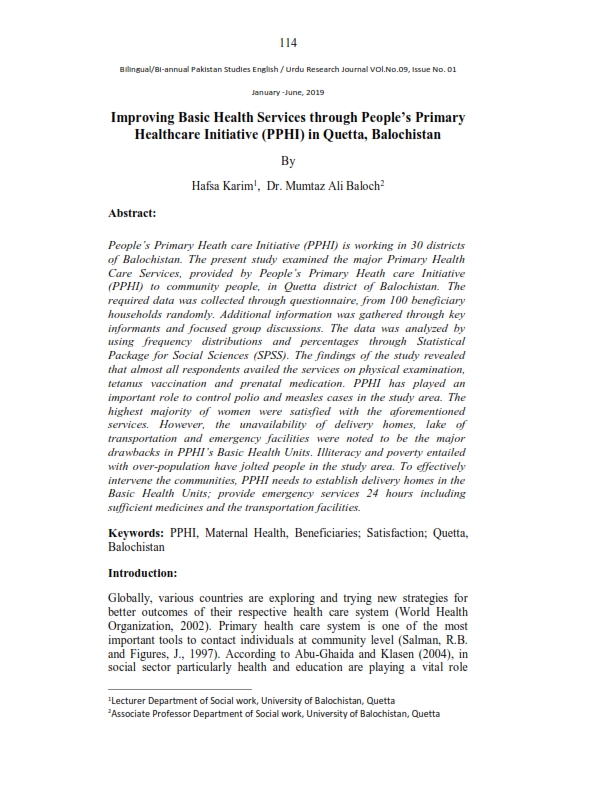Improving Basic Health Services through People’s Primary Healthcare Initiative (PPHI) in Quetta, Balochistan
Keywords:
PPHI, Maternal Health, Beneficiaries; Satisfaction; Quetta, BalochistanAbstract
People’s Primary Heath care Initiative (PPHI) is working in 30 districts
of Balochistan. The present study examined the major Primary Health
Care Services, provided by People’s Primary Heath care Initiative
(PPHI) to community people, in Quetta district of Balochistan. The
required data was collected through questionnaire, from 100 beneficiary
households randomly. Additional information was gathered through key
informants and focused group discussions. The data was analyzed by
using frequency distributions and percentages through Statistical
Package for Social Sciences (SPSS). The findings of the study revealed
that almost all respondents availed the services on physical examination,
tetanus vaccination and prenatal medication. PPHI has played an
important role to control polio and measles cases in the study area. The
highest majority of women were satisfied with the aforementioned
services. However, the unavailability of delivery homes, lake of
transportation and emergency facilities were noted to be the major
drawbacks in PPHI’s Basic Health Units. Illiteracy and poverty entailed
with over-population have jolted people in the study area. To effectively
intervene the communities, PPHI needs to establish delivery homes in the
Basic Health Units; provide emergency services 24 hours including
sufficient medicines and the transportation facilities.
References
Abu-Ghaida, D., &Klasen, S. (2004). The costs of missing the Millennium
Development Goal on gender equity. World Development, 32(7),
-1107, Germany
Akram, M. and F. Khan (2007) Health Care Services and Government
Spending in
Pakistan. Pakistan Institute of Development Economics, (PIDE Working
Paper 2007: 32), Islamabad
Central Intelligence Agency CIA world fact Book ,2008/ prepared by
central intelligence agency, Pakistan.
Duclos P, Okwo-Bele JM, Gacic-Dobo M, Cherian T. Global
immunization: status, progress, challenges and future (2009).
Department of Immunization, Vaccines and Biologicals, World
Health Organization, CH-1211 Geneva 27, Switzerland.
Economic Survey of Pakistan 2002-2003.Finance Division, Government
of Pakistan
chapters/13-populationMay 6, 2004 sahaidsha school of economics,
Lahore.
Federal Bureau of Statistics 2007, Pakistan national health accounts
report, Islambad.
Human development report (2007/2008). Fighting climate change human
solidarity in a divided world published for (UNDP) united nation
development program, leading author Kevin Watkins.
Lashari, I., Bhatti, S., &Hasan, R. S. (2004). Enteric fever in adult
patients: Clinical features, outcome and antibiotic susceptibility
patterns, 13, 68-72. Pakistan.
Local Government Ordinance 2001 New Local Government System: A
Step Towards Community Empowerment Zulqarnain Hussain
Anjum
PPHI-Balochistan (2016). Annual report volume 12, Quetta.
Pakistan social and living standards measurements survey (P S L M –
-15). National / Provincial /District Government of Pakistan
Statistics Division Pakistan Bureau of Statistics Islamabad March2016, National.
Sabih F, Bille KM, Buehler W, Hafeez A, Nishtar S, Siddiqi S:
Implementing the district health system in the framework of
primary health care in Pakistan: can the evolving reforms enhance
the pace towards the Millennium Development Goals East
Mediator Health J 2010,
Suppl:S132–S144, Pakistan.
Saltman, Richard B., Figueras, Josep, Sakellarides, Constantino Critical
Challenges for Health Care Reform in Europe.
Siddiqi, S., Haq, I. U., Ghaffar, A., Akhtar, T., &Mahaini, R. (2004).
Pakistan’s maternal and child health policy: analysis, lessons and
the way forward. Health policy, 69(1), 117-130, Islamabad
World Health Organization (2002). The World Health Report: Reducing
Risks, Promoting Healthy Life Country….
William E (2002). How did heavily indebted poor countries become
heavily in debt reviewing two decades of debt relief, publication
world development publisher Elsevier Netherlands.



